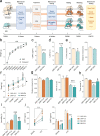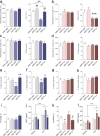A novel murine model to study the impact of maternal depression and antidepressant treatment on biobehavioral functions in the offspring
- PMID: 34002019
- PMCID: PMC8760069
- DOI: 10.1038/s41380-021-01145-7
A novel murine model to study the impact of maternal depression and antidepressant treatment on biobehavioral functions in the offspring
Abstract
Antenatal psychopathology negatively affects obstetric outcomes and exerts long-term consequences on the offspring's wellbeing and mental health. However, the precise mechanisms underlying these associations remain largely unknown. Here, we present a novel model system in mice that allows for experimental investigations into the effects of antenatal depression-like psychopathology and for evaluating the influence of maternal pharmacological treatments on long-term outcomes in the offspring. This model system in based on rearing nulliparous female mice in social isolation prior to mating, leading to a depressive-like state that is initiated before and continued throughout pregnancy. Using this model, we show that the maternal depressive-like state induced by social isolation can be partially rescued by chronic treatment with the selective serotonin reuptake inhibitor, fluoxetine (FLX). Moreover, we identify numerous and partly sex-dependent behavioral and molecular abnormalities, including increased anxiety-like behavior, cognitive impairments and alterations of the amygdalar transcriptome, in offspring born to socially isolated mothers relative to offspring born to mothers that were maintained in social groups prior to conception. We also found that maternal FLX treatment was effective in preventing some of the behavioral and molecular abnormalities emerging in offspring born to socially isolated mothers. Taken together, our findings suggest that the presence of a depressive-like state during preconception and pregnancy has sex-dependent consequences on brain and behavioral functions in the offspring. At the same time, our study highlights that FLX treatment in dams with a depression-like state can prevent abnormal behavioral development in the offspring.
© 2021. The Author(s).
Conflict of interest statement
The authors declare no competing interests.
Figures





Similar articles
-
Fluoxetine normalizes the effects of prenatal maternal stress on depression- and anxiety-like behaviors in mouse dams and male offspring.Behav Brain Res. 2016 Sep 15;311:354-367. doi: 10.1016/j.bbr.2016.05.062. Epub 2016 Jun 1. Behav Brain Res. 2016. PMID: 27263073
-
Perinatal fluoxetine treatment and dams' early life stress history alter affective behavior in rat offspring depending on serotonin transporter genotype and sex.Behav Brain Res. 2020 Aug 17;392:112657. doi: 10.1016/j.bbr.2020.112657. Epub 2020 Apr 24. Behav Brain Res. 2020. PMID: 32339551
-
Perinatal fluoxetine treatment and dams' early life stress history have opposite effects on aggressive behavior while having little impact on sexual behavior of male rat offspring.Psychopharmacology (Berl). 2020 Sep;237(9):2589-2600. doi: 10.1007/s00213-020-05535-7. Epub 2020 Jul 17. Psychopharmacology (Berl). 2020. PMID: 32676774 Free PMC article.
-
Long-term outcomes of developmental exposure to fluoxetine: a review of the animal literature.Dev Neurosci. 2013;35(6):437-9. doi: 10.1159/000355709. Dev Neurosci. 2013. PMID: 24247012 Review.
-
Epigenetic Alterations in DNA and Histone Modifications Caused by Depression and Antidepressant Drugs: Lessons from the Rodent Models.Curr Pharm Des. 2017;23(44):6828-6840. doi: 10.2174/1381612823666171031110734. Curr Pharm Des. 2017. PMID: 29086676 Review.
Cited by
-
Mouse Model of Weak Depression Exhibiting Suppressed cAMP Signaling in the Amygdala, Lower Lipid Catabolism in Liver, and Correlated Gut Microbiota.Front Behav Neurosci. 2022 May 19;16:841450. doi: 10.3389/fnbeh.2022.841450. eCollection 2022. Front Behav Neurosci. 2022. PMID: 35928791 Free PMC article.
-
Prenatal and postnatal influences on behavioral development in a mouse model of preconceptional stress.Neurobiol Stress. 2024 Feb 3;29:100614. doi: 10.1016/j.ynstr.2024.100614. eCollection 2024 Mar. Neurobiol Stress. 2024. PMID: 38357099 Free PMC article.
-
Association of maternal postpartum depression symptoms with infant neurodevelopment and gut microbiota.Front Psychiatry. 2024 May 21;15:1385229. doi: 10.3389/fpsyt.2024.1385229. eCollection 2024. Front Psychiatry. 2024. PMID: 38835546 Free PMC article.
-
Depression and health outcomes: An umbrella review of systematic reviews and meta-analyses of observational studies.Transl Psychiatry. 2025 Aug 20;15(1):298. doi: 10.1038/s41398-025-03463-8. Transl Psychiatry. 2025. PMID: 40835677 Free PMC article.
-
Ethopharmacological evaluation of antidepressant-like effect of serotonergic psychedelics in C57BL/6J male mice.Naunyn Schmiedebergs Arch Pharmacol. 2024 May;397(5):3019-3035. doi: 10.1007/s00210-023-02778-x. Epub 2023 Oct 24. Naunyn Schmiedebergs Arch Pharmacol. 2024. PMID: 37874338
References
-
- Fisher J, Cabral de Mello M, Patel V, Rahman A, Tran T, Holton S, et al. Prevalence and determinants of common perinatal mental disorders in women in low- and lower-middle-income countries: a systematic review. Bull World Health Organ. 2012;90:139G–149G. doi: 10.2471/BLT.11.091850. - DOI - PMC - PubMed
-
- Loomans EM, van Dijk AE, Vrijkotte TG, van Eijsden M, Stronks K, Gemke RJ, et al. Psychosocial stress during pregnancy is related to adverse birth outcomes: results from a large multi-ethnic community-based birth cohort. Eur J Public Health. 2013;23:485–491. doi: 10.1093/eurpub/cks097. - DOI - PubMed
Publication types
MeSH terms
Substances
LinkOut - more resources
Full Text Sources
Other Literature Sources
Medical

